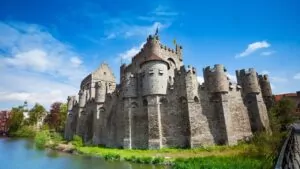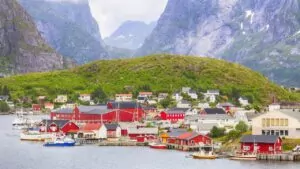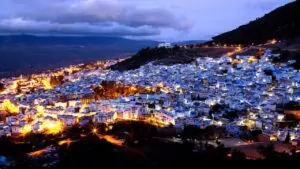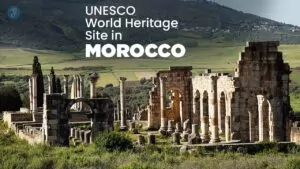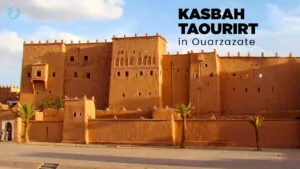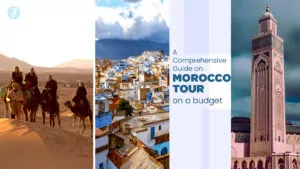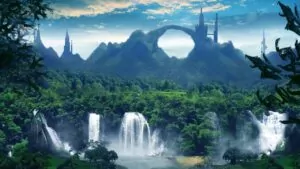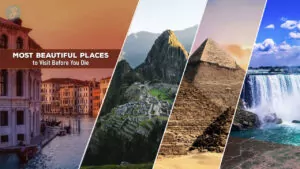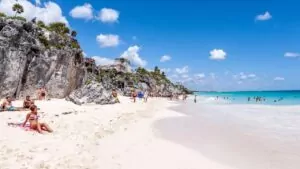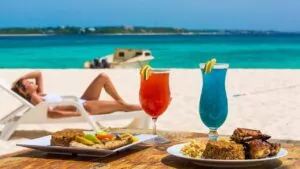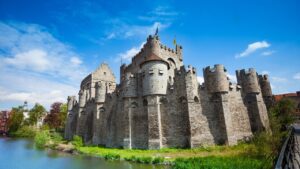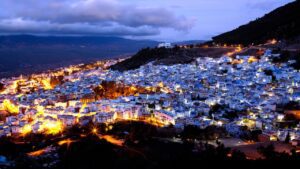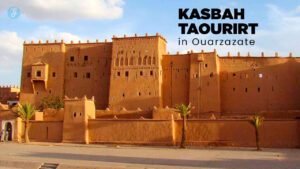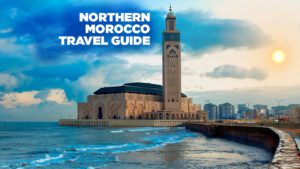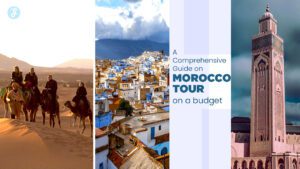Iceland’s summer brings a magical display of endless daylight from mid-May through July. The midnight sun creates a golden glow that bathes the volcanic landscapes and glaciers in warm light for up to 24 hours straight.
This natural wonder lets you pack more adventures into your day – from late-night glacier hikes to evening whale watching tours under the bright sky.
The endless summer days give you total freedom to explore Iceland’s raw beauty without watching the clock. You can start your morning at the Blue Lagoon, spend afternoon hours discovering waterfalls, and still catch stunning photos of the glowing midnight sun over Thingvellir National Park at 11 PM.
The summer light transforms Iceland’s already striking scenery into something even more spectacular. Discover why travel to Iceland is a must for you in 2025.
Chase the Winter Northern Lights
While summer brings endless daylight, winter transforms Iceland into a magical light show. The Northern Lights dance across the dark sky from September through March. These green, purple, and pink ribbons of light create a natural display that draws visitors from around the globe.
The best spots to catch this light show include Thingvellir National Park and the remote areas near Lake Myvatn. Clear, cold nights offer the perfect setting for aurora viewing. Many tour guides track weather patterns and solar activity to boost your chances of seeing this natural wonder.
They drive to spots away from city lights where the sky puts on its best performance. The mix of active volcanoes and glacial landscapes below adds extra magic to your aurora adventure.
Witness Amazing Icelandic Wildlife

Iceland’s waters burst with life as massive whales breach the surface and splash back into the deep blue sea. Thousands of colorful puffins nest along the coastal cliffs from April to August, making Iceland one of the best spots in the world to watch these charming seabirds up close.
Top whale watching and puffin tours
The coastal waters of Iceland teem with majestic whales and adorable puffins. Several tour operators run daily trips to spot these amazing creatures in their natural habitat.
- Husavik Traditional Whale Watching takes you on wooden boats to see blue whales, humpbacks, and orcas. The expert guides share facts about marine life while you sail through the pristine Arctic waters.
- North Sailing offers eco-friendly tours on restored oak ships from April to October. Guests often spot dolphins, porpoises, and up to 23 whale species during peak season.
- Elding Adventure at Sea runs 3-hour trips from Reykjavik’s Old Harbor. The modern vessels have heated indoor cabins and viewing decks perfect for photographing breaching whales.
- Special Tours combines whale watching with puffin colony visits to Lundey Island. The small boats get close to cliffs where thousands of puffins nest from May through August.
- Arctic Sea Tours provides intimate zodiac boat rides for maximum wildlife viewing. The fast, stable boats reach prime spots quickly while skilled captains track whale movements.
- Gentle Giants runs tours in Skjalfandi Bay, home to abundant marine life. Their specialized RIB boats offer thrilling yet safe encounters with these ocean giants.
- Lakitours operates year-round whale watching from the Snaefellsnes Peninsula. Winter tours often include stunning northern lights displays over the water.
Next up, we’ll explore the wonders waiting at Thingvellir National Park.
Explore Thingvellir National Park
Thingvellir National Park sits at the spot where two giant continents meet, creating deep cracks in the earth’s surface. You can walk between the North American and Eurasian tectonic plates while taking in views of Iceland’s largest natural lake and ancient Viking parliament grounds.
Top Golden Circle tours
Iceland’s Golden Circle stands as the country’s most famous sightseeing route. Travelers flock to this 300-kilometer loop from Reykjavik to see three stunning natural landmarks.
- Classic Golden Circle Tour spans 6-8 hours and stops at Gullfoss waterfall, where glacial waters plunge 32 meters into a narrow canyon
- Express Golden Circle Tour takes 4-5 hours, perfect for time-pressed visitors who want to see the main attractions without extra stops
- Super Jeep Golden Circle Adventure includes off-road driving through rough terrain and visits to secret spots most tourists miss
- Golden Circle and Secret Lagoon Tour combines the main sights with a relaxing dip in a natural hot spring that stays at 38-40°C year-round
- Northern Lights and Golden Circle Combo Tour runs from September to April, mixing daytime sightseeing with evening aurora hunting
- Small Group Golden Circle Tour limits groups to 12 people, offering more personal attention and flexible photo stops
- Golden Circle Food Tour adds local farm visits and traditional Icelandic food tastings to the regular route
- Snowmobile and Golden Circle Tour lets visitors zoom across Langjökull glacier after seeing the main attractions
- Private Golden Circle Tour offers custom schedules and exclusive guide attention for families or small groups
- Golden Circle and Glacier Tour combines the classic route with a guided walk on one of Iceland’s massive ice fields
Hike Stunning Mountains and Trails
Mountain trails in Iceland offer pure magic for hiking fans. Rugged peaks rise from black sand deserts, while hidden valleys showcase bright green moss against dark volcanic rocks.
Trails range from easy walks to challenging climbs, perfect for both new hikers and seasoned trekkers. The paths wind through lava fields and past steaming vents, showing off the raw power of this volcanic landscape.
Hikers can explore paths near active volcanoes and across ancient glacial formations. The summer midnight sun lights up trails for extended hiking hours, making it easy to spot local wildlife.
Popular routes take you through Thingvellir National Park’s dramatic rifts and along the famous Laugavegur trail. The clear marked paths keep adventures safe while leading to amazing views of waterfalls, hot springs, and vast ice fields.
Experience Iceland’s Glaciers and Ice Caves
Iceland’s massive glaciers and deep ice caves create a magical winter wonderland from November to March. You can walk through crystal-blue ice tunnels and climb frozen waterfalls with expert guides who know every crack and crevice of these ancient ice formations.
Top glacier tours
Glacier tours stand as a top draw for adventure seekers in Iceland. These icy giants cover 11% of the country’s surface, making them perfect for thrilling explorations.
- Vatnajökull Glacier Tour takes you across Europe’s largest ice cap. The tour includes ice climbing, walking through blue ice caves, and spotting stunning ice formations.
- Sólheimajökull Glacier Walk offers a perfect mix of hiking and ice climbing. Guides teach basic climbing skills while sharing facts about the glacier’s formation.
- Langjökull Ice Cave Tour leads deep into man-made tunnels. The bright blue walls and crystal clear ice create amazing photo chances.
- Skaftafell Glacier Adventure combines hiking with amazing mountain views. The tour includes stops at natural ice caves and crevasses.
- Into the Glacier Experience takes you inside Iceland’s second-largest glacier. You’ll ride in special trucks built for ice travel.
- Snæfellsjökull Glacier Tour explores the famous glacier from Jules Verne’s books. The tour mixes hiking with stories about local myths.
- Crystal Ice Cave Tour runs during winter months only. The natural caves show off stunning blue ice formations and volcanic ash layers.
- Falljökull Glacier Climb suits experienced climbers. The steep ice walls offer tough but rewarding challenges.
- Mýrdalsjökull Snowmobile Tour zips across vast ice fields. The tour includes views of the active Katla volcano below.
- Jökulsárlón Glacier Lagoon Tour shows off floating icebergs. Boat rides take you close to these massive ice chunks.
Relax in Geothermal Baths and Spas
Iceland’s geothermal baths offer pure bliss after a day of adventure. Natural hot springs dot the landscape, from fancy spa resorts to hidden mountain pools. The Blue Lagoon stands out as the most famous spot, with its milky-blue waters rich in minerals and silica.
Guests can float in the warm waters while taking in views of snow-capped mountains and rugged lava fields.
Local spas tap into Iceland’s volcanic energy to create steamy outdoor havens. Many spots feature multiple pools at different temperatures, steam rooms, and saunas. The Myvatn Nature Baths in North Iceland gives visitors a less crowded option than the Blue Lagoon.
These healing waters help tired muscles recover from hiking glaciers or exploring ice caves. Most pools stay open year-round, letting you soak under the midnight sun in summer or watch the northern lights dance above in winter.
Discover the Icelandic Highlands in a 4×4
The Icelandic Highlands offer raw adventure in its purest form. A 4×4 vehicle takes you deep into rough terrain filled with volcanic peaks, massive glaciers, and steaming hot springs.
These remote areas show off nature’s raw power through black desert landscapes and rainbow-colored mountains. The rugged paths lead to hidden waterfalls and crystal-clear streams that few tourists ever see.
Driving through the Highlands puts you face-to-face with Europe’s largest glaciers and most active volcanoes. Your 4×4 journey crosses rivers, climbs mountains, and rolls past lava fields that stretch for miles.
The roads stay open from June to September, giving you perfect chances to spot Arctic foxes or wild reindeer. Super Jeep tours make these wild places easy to reach, even for first-time visitors.
Meet the Unique Icelandic Horse
Icelandic horses stand out as the country’s most beloved animals, with their small size and thick winter coats making them perfect for the harsh climate. These sturdy creatures have lived on the island since Viking times, and their pure bloodline remains unchanged for over 1,000 years thanks to strict breeding laws.
Top horse riding tours
The gentle Icelandic horses offer a perfect way to explore Iceland’s rough terrain. These special breeds stand out for their smooth gait and friendly nature, making them great companions for both new and skilled riders.
- Viking Horse Adventure takes you through ancient lava fields near Reykjavik. The tour lasts 3 hours and includes basic riding lessons for beginners.
- Glacier View Ride brings riders close to Europe’s largest glacier, Vatnajökull. Riders cross black sand beaches and get amazing views of ice caps during this 4-hour journey.
- Golden Circle Riding Tour combines popular sights with horseback adventures. You’ll ride past geothermal areas and visit the famous Gullfoss waterfall in a 6-hour trip.
- Northern Lights Horse Riding Tour runs from September to April. This night ride offers chances to see the aurora while riding through moonlit landscapes.
- South Coast Beach Ride takes you along Iceland’s famous black sand beaches. The 2-hour ride includes views of sea stacks and hidden caves.
- Mountain Valley Tour leads through green valleys and crystal-clear streams. This 5-hour ride suits riders who want to see Iceland’s untouched nature.
- Midnight Sun Ride runs during summer months. Riders experience the endless daylight while crossing moss-covered lava fields.
- Farm and Stable Visit Tour teaches about horse care and breeding. This 2-hour program includes short rides and time with foals during summer.
- Multi-Day Horse Trek explores the highlands and remote areas. Riders sleep in mountain huts and ride through varied landscapes over 3-5 days.
- Family Horse Experience offers shorter rides for kids and parents. The 1-hour program includes meeting friendly horses and basic riding skills.
Savor Hearty Icelandic Cuisine
Icelandic food brings bold flavors from both land and sea to your plate. Fresh Arctic char, tender lamb, and creamy skyr yogurt stand as staples of local dining. Adventurous eaters can try traditional dishes like hákarl (fermented shark) or svið (singed sheep’s head).
Most restaurants across Iceland serve modern takes on classic recipes, blending old traditions with new cooking styles.
Local chefs create magic with simple ingredients from Iceland’s pure environment. Fish comes straight from crystal-clear waters, while free-roaming lambs graze on wild herbs in mountain pastures.
Popular spots like Grillmarkaðurinn in Reykjavik serve up hot spring bread baked in geothermal ovens. Food tours give visitors a chance to taste authentic dishes while learning about Iceland’s rich culinary history.
Visit Lake Myvatn and Its Surrounding Wonders
Lake Myvatn sparkles like a jewel in northern Iceland, surrounded by bubbling mud pots and steaming vents that create an otherworldly landscape. The area draws nature lovers to its rich bird life, with over 13 duck species making their home among the volcanic formations and crystal-clear waters.
Top Myvatn tours
Myvatn stands as one of Iceland’s most stunning natural wonders, packed with volcanic landscapes and geothermal features. Nature lovers flock to this area for its rich wildlife and dramatic scenery that showcases the raw power of Iceland’s geology.
- Diamond Circle Super Jeep Tour takes you through rugged terrains to see steaming fumaroles and bubbling mud pots near the volcanic zone. This 8-hour adventure includes stops at Dettifoss waterfall and the Hverir geothermal area.
- Myvatn Nature Baths Tour offers a more relaxed way to enjoy the area’s geothermal activity. You’ll soak in mineral-rich waters while gazing at the volcanic landscape around you.
- Bird Watching Tours run from May to August, perfect for spotting some of the 15 duck species that call Myvatn home. Expert guides help track rare birds across the lake’s shores.
- Lava Cave Exploration Tour takes you inside Grjótagjá, a natural cave with hot springs. The cave gained fame as a Game of Thrones filming location.
- Northern Lights Tour combines Myvatn’s dark winter skies with hot spring visits. Groups stay small, maxing at 8 people for better viewing chances.
- Volcano Sightseeing Tour shows off Krafla’s active volcanic area. You’ll see the Viti crater and walk through fresh lava fields from recent eruptions.
- Photography Tours focus on capturing the area’s best angles. Pro photographers guide you to secret spots during golden hour lighting.
- Hiking Tours cross through varied landscapes from pseudo craters to frozen lava formations. Each trail offers different difficulty levels for all abilities.
- Winter Ice Cave Tours venture into natural ice formations near the lake. Guides bring special gear and safety equipment for these frozen adventures.
Descend into Fiery Craters and Volcanoes
Iceland’s active volcanoes offer thrilling adventures into the Earth’s fiery core. You can trek through lava fields, peer into steaming craters, and even explore inside dormant volcanic tubes that snake beneath the surface.
Top volcano tours
Volcano tours stand as a major draw for adventure seekers in Iceland. These guided excursions take visitors close to active volcanoes and showcase the raw power of nature.
- Thrihnukagigur Volcano Tour lets you descend 400 feet into a dormant volcano’s magma chamber through a special lift system
- Fagradalsfjall Volcano Hike takes you across fresh lava fields from the 2021 eruption, with steaming grounds and vibrant colors
- Katla Ice Cave and Volcano Tour combines glacier walking with volcanic exploration near one of Europe’s largest ice caps
- Askja Caldera Tour drives you through rough highland roads to reach a massive volcanic crater filled with milky blue water
- Leirhnjukur Volcanic Area Tour shows you bubbling mud pots and steam vents in the active Krafla volcanic zone
- Mount Hekla Super Jeep Tour brings you up close to “The Gateway to Hell” – one of Iceland’s most active volcanoes
- Snaefellsjokull National Park Tour explores an ancient volcanic system topped by a glacier made famous in Jules Verne’s writing
- Eyjafjallajokull Volcano Tour visits the site of the famous 2010 eruption that stopped European air traffic
- Volcanic Beach Tour takes you along black sand shores created by centuries of volcanic activity
- Inside the Volcano Tour offers a rare chance to enter Víti crater and see its colorful mineral deposits
Stroll Along Famous Black Sand Beaches
Iceland’s black sand beaches stretch for miles along the southern coast, where volcanic rocks meet the wild Atlantic waves, creating a dramatic scene that feels like walking on another planet – grab your camera and explore these otherworldly shores during your next Iceland trip.
Top Jokulsarlon tours
Jokulsarlon Glacier Lagoon stands as one of Europe’s most stunning natural wonders. The crystal-clear waters filled with floating icebergs create a photographer’s dream setting against the backdrop of Vatnajökull, Europe’s largest glacier.
- Amphibian Boat Tour takes you right up to the massive icebergs. The 40-minute ride lets you touch ancient ice chunks while expert guides share facts about glacier formation.
- Zodiac Boat Tour offers a more thrilling ride through the lagoon. Small groups of 10 people get closer to the ice walls and spot seals playing in the water.
- Diamond Beach Photography Tour combines the lagoon visit with the nearby black sand beach. You’ll capture stunning shots of ice diamonds scattered across volcanic sand.
- Ice Cave and Lagoon Combo Tour gives you access to natural ice caves from November to March. The bright blue ice walls show nature’s raw beauty up close.
- Northern Lights Lagoon Tour runs during winter months. The dark skies above the floating icebergs create perfect spots to watch the aurora dance.
- Glacier Hike and Lagoon Tour pairs two amazing activities in one day. You’ll walk on Vatnajökull Glacier before exploring the lagoon’s wonders.
- Summer Midnight Sun Tour shows the lagoon in a magical golden light. The endless sunset creates perfect photo conditions from June to July.
- Private Photography Workshop helps you capture pro-level shots. Expert guides teach you camera settings for ice and water photography.
- Kayak Adventure Tour puts you at water level with the icebergs. Small groups paddle through the calm waters for an intimate glacier experience.
Admire Iceland’s Iconic Waterfalls
Iceland’s waterfalls stand as natural wonders that draw visitors from across the globe. Massive cascades thunder down volcanic cliffs, creating rainbows in their mist. Seljalandsfoss lets you walk behind its 200-foot curtain of water, while Skógafoss drops with enough force to spray mist hundreds of feet into the air.
The raw power of Dettifoss, Europe’s most powerful waterfall, shows off Iceland’s mighty natural forces.
These waterfalls tell stories of Iceland’s glacial rivers cutting through ancient lava fields. Each fall offers perfect spots for photos, hiking trails, and places to feel nature’s raw energy up close.
The best times to visit come during summer’s midnight sun or winter’s snow-covered landscapes. The roar of rushing water mixes with the stark beauty of black volcanic rocks. Next up, you’ll want to grab your keys for an epic road trip through this land of natural wonders.
Escape on an Epic Road Trip
A road trip through Iceland opens up endless paths to explore glaciers, volcanoes, and hidden waterfalls at your own pace. The Ring Road circles the entire island in 828 miles, letting you stop at black sand beaches, steaming hot springs, and rugged lava fields along the way.
Many travelers rent 4×4 vehicles to tackle rough terrain and reach remote spots like the Highlands’ untamed wilderness areas.
The freedom of driving gives you time to spot wild reindeer, photograph the Midnight Sun, or chase the Northern Lights without strict schedules. Most rental companies offer sturdy cars built for Iceland’s weather, plus GPS systems and safety gear for your journey.
Your next stop awaits at Lake Myvatn, where otherworldly landscapes and geothermal wonders create an unforgettable experience.
When to Visit Iceland
Iceland’s seasons paint two different pictures for travelers. Summer brings endless daylight and mild temperatures perfect for outdoor adventures, while winter creates a magical wonderland with dark skies that dance with the northern lights.
Summer vs. winter experiences
The dramatic seasonal changes in Iceland create two distinct travel experiences. Each season offers spectacular outdoor activities and natural phenomena that will leave you spellbound.
| Summer Experiences | Winter Experiences |
|---|---|
| 24 hours of daylight (Midnight Sun) | Northern Lights dancing across dark skies |
| Temperatures between 50-60°F (10-15°C) | Temperatures between 20-30°F (-6 to -1°C) |
| Puffin watching along coastal cliffs | Ice cave explorations in glaciers |
| Highland hiking trails open | Snowmobile rides across glaciers |
| Whale watching in warmer waters | Winter photography tours |
| Mountain biking on green trails | Skiing and snowboarding |
| Camping under bright skies | Cozy stays in glass igloos |
| River rafting adventures | Hot spring dips amid snow |
| Wild berry picking | Christmas markets and festivals |
| Better road conditions for driving | Dog sledding tours |
| Peak tourist season (higher prices) | Off-peak season (better deals) |
| More frequent tour departures | Smaller tour groups |
Best Ways to Travel Around Iceland
Renting a car gives you total freedom to explore Iceland’s stunning landscapes at your own pace, while guided tours offer stress-free travel with expert local knowledge – click through to learn more about your transport options in Iceland.
Renting a car or campervan
Iceland’s vast landscapes call for personal transport to explore its natural wonders. A rental vehicle gives you the freedom to discover hidden gems across this stunning island nation.
- Most car rental companies in Iceland need drivers to be at least 20 years old with a valid license held for one year.
- Manual transmission cars cost less than automatic ones in Iceland, saving you money for other adventures.
- Four-wheel drive vehicles prove essential from September to May due to Iceland’s rough terrain and weather changes.
- Major rental companies like Hertz, Budget, and local firms offer pick-up services at Keflavík International Airport.
- Campervans combine transport and lodging, cutting accommodation costs while offering flexibility to sleep near glaciers and waterfalls.
- Insurance packages must cover gravel roads, ash, and sand damage specific to Iceland’s conditions.
- Gas stations appear less frequently in rural areas, so fill up whenever possible during your journey.
- GPS navigation comes standard with most rentals, helping you find remote attractions like hidden hot springs.
- Winter driving requires special skills and attention to road conditions, especially on mountain passes.
- Local agencies often provide better rates and more personal service than international companies.
- Parking remains free in most areas outside Reykjavík’s city center.
- Vehicle inspections before and after rental prevent disputes about existing damage.
The next section explores the Diamond Circle, a spectacular driving route in northern Iceland.
Essential Tips for Shoulder-Season Travel
Spring and fall travel to Iceland brings special rewards. Tourists can enjoy smaller crowds at popular spots like Thingvellir National Park and the Blue Lagoon during these months.
The weather stays mild enough for outdoor activities, yet prices drop for hotels and flights. Smart travelers pack layers of warm clothes and waterproof gear to handle quick weather changes.
Many tours still run during shoulder season, offering closer views of waterfalls and glaciers without summer’s busy crowds.
Road conditions need extra care in shoulder months, but most main routes stay open. The F-roads through the highlands close, but the Ring Road gives access to major sights. Booking ahead helps grab good deals on accommodation and rental cars.
The northern lights start showing up in late September, while March brings longer daylight hours perfect for exploring ice caves and lava fields. Nature lovers get amazing chances to spot wildlife like whales and puffins starting their seasonal moves.
Next up, we’ll explore how Iceland leads the way in eco-friendly tourism.
Iceland’s Eco-Friendly Tourism Practices
Iceland leads the way in green tourism practices. The country runs on 100% renewable energy from its geothermal and hydroelectric sources. Local hotels use eco-friendly materials and smart technology to cut down waste.
Tour operators follow strict rules to protect the glaciers, volcanoes, and wildlife during adventures. Many restaurants serve fresh, local food to reduce carbon footprints from shipping.
Tourists play a big role in Iceland’s environmental efforts. The country asks visitors to stick to marked paths, avoid disturbing wildlife, and use reusable water bottles. Many tour companies plant trees to offset carbon from their trips.
Iceland’s commitment to nature shows in its clean air, pure water, and protected landscapes. The Blue Lagoon uses its geothermal water in smart ways, from heating nearby buildings to growing algae for skincare products.
Now, let’s explore the vibrant city life and must-do activities in Reykjavik.
Must-Do Activities in Reykjavik
Reykjavik buzzes with fun activities for every traveler. The city’s main street, Laugavegur, offers great spots for shopping and dining on tasty Icelandic food. Visitors love to climb the Hallgrimskirkja church tower for amazing city views.
The Harpa Concert Hall stands out with its glass walls that shine in different colors at night. People can join whale watching tours right from the old harbor or take a dip in any of the city’s warm geothermal pools.
Local museums tell stories about Vikings and Iceland’s rich past. The National Museum shows off ancient treasures, while the Whales of Iceland museum teaches about sea life. Food lovers must try the famous hot dogs at Bæjarins Beztu Pylsur or fresh fish at the Grandi Food Hall.
Art fans can spot cool street art all over downtown or check out modern pieces at the Reykjavik Art Museum. The Blue Lagoon sits just outside the city, making it perfect for a relaxing soak.
Next up, let’s explore the famous Blue Lagoon experience.
The Blue Lagoon stands as Iceland’s most famous geothermal spa. Its milky-blue waters stretch across black lava fields, creating a striking contrast against the rugged landscape. The water stays warm at 98-104°F year-round, packed with minerals like silica and sulfur.
Visitors float in the healing waters while treating their faces with silica mud masks from the wooden boxes placed around the lagoon.
The spa offers premium packages with private changing rooms, fluffy robes, and special access to the Lava Restaurant. Guests can swim up to the bar for smoothies or local beers without leaving the warm water.
The steam caves and saunas add extra comfort to the bathing ritual. Moving on to the South Coast, travelers will discover another side of Iceland’s natural wonders.
Explore the South Coast
Iceland’s South Coast packs a punch with natural wonders at every turn. Massive waterfalls like Seljalandsfoss and Skógafoss thunder down black cliffs, while volcanic beaches stretch for miles.
Visitors can walk behind Seljalandsfoss’s curtain of water or climb to the top of Skógafoss for amazing views. The area also features active volcanoes, sprawling glaciers, and rugged lava fields that create an otherworldly landscape.
Adventure seekers flock to this region for glacier hiking on Sólheimajökull and ice cave tours in winter months. Black sand beaches at Reynisfjara showcase dramatic rock formations and towering sea stacks.
Many travelers start their South Coast journey from Reykjavik, making stops at key spots along Route 1. Small fishing villages dot the coastline, offering fresh seafood and glimpses into local life.
Discover the Diamond Circle
The Diamond Circle offers travelers a stunning route through North Iceland’s natural wonders. This 250-mile loop features the mighty Dettifoss waterfall, Europe’s most powerful cascade, along with the horseshoe-shaped Ásbyrgi canyon.
Nature lovers flock to the steaming vents and bubbling mud pots near Lake Mývatn, where volcanic activity shapes the landscape.
The route connects several must-see spots in northern Iceland through paved roads and gravel paths. Visitors can spot whales breaching off the coast of Húsavík, known as Europe’s whale-watching capital.
The area boasts active volcanoes, hot springs, and dramatic lava fields that showcase the raw power of nature. Tour companies run daily trips from April through October, with summer bringing the bonus of midnight sun views across this otherworldly terrain.
Photography Opportunities in Iceland
Iceland stands as a photographer’s dream with its dramatic landscapes and natural wonders. Massive glaciers, active volcanoes, and stunning waterfalls create perfect shots at every turn.
Black sand beaches offer striking contrasts against white waves and blue skies. Nature photographers flock to capture the Northern Lights dancing across winter skies or the Midnight Sun casting golden hues during summer months.
Professional and amateur photographers find endless subjects in Iceland’s raw beauty. Glacier caves sparkle with blue ice formations, while geothermal areas steam with colorful mineral deposits.
Wildlife enthusiasts snap photos of whales breaching near the coast or puffins nesting on seaside cliffs. Mountain ranges and lava fields stretch as far as the eye can see, giving photographers countless chances to capture Iceland’s wild spirit.
Each season brings new photo opportunities – from snow-covered landscapes in winter to green valleys dotted with wildflowers in summer.
Top Cultural Experiences to Enjoy
Locals invite guests to taste traditional delicacies like fermented shark and smoked lamb at food festivals across the country. Cultural museums showcase Viking history through ancient artifacts and interactive displays.
Folk tales come alive during storytelling nights at cozy cafes, where guests learn about trolls and hidden people. Traditional music fills concert halls as performers play the langspil, a traditional Icelandic string instrument.
Art galleries display works from local painters and sculptors who draw inspiration from the raw landscape. Visitors can join cooking classes to learn family recipes passed down through generations.
The yearly Winter Lights Festival brings together music, art, and food in a celebration of Icelandic culture. Traditional craft workshops teach ancient skills like wool knitting and silver making.
Moving on to safety tips will help you make the most of these cultural activities….
Safety Tips for Tourists in Iceland
While Iceland’s rich cultural heritage offers amazing experiences, staying safe remains crucial during your adventure. Iceland ranks as the safest country globally, but nature demands respect in this land of extremes.
- Pack proper winter gear with waterproof jackets and boots for Iceland’s quick-changing weather patterns.
- Stay on marked paths at all tourist sites – the ground near geothermal areas can be thin and dangerous.
- Check road conditions daily through the official Iceland weather website before driving anywhere.
- Keep a charged phone and download the 112 Iceland App for emergency help.
- Stay at least 100 meters away from glacier edges unless with a certified guide.
- Bring crampons for walking on icy surfaces during winter months.
- Fill up your gas tank before long drives – stations can be far apart in rural areas.
- Never swim in glacier lakes or climb on icebergs at Jökulsárlón.
- Park only in designated areas near waterfalls and volcanic sites.
- Carry basic first aid supplies and any needed medications.
- Save emergency numbers: 112 for general help, 1777 for road conditions.
- Book guided tours for glacier hikes, ice caves, and volcano visits.
- Tell someone your travel plans if exploring remote areas.
- Stay behind safety ropes at popular sites like Gullfoss and Geysir.
- Watch weather alerts through the Icelandic Met Office website.
Packing Essentials for Your Iceland Adventure
Iceland’s harsh weather demands smart packing choices for your adventure. Your comfort and safety depend on bringing the right gear to handle both fire and ice landscapes.
- Waterproof hiking boots protect your feet during glacier walks and volcanic terrain exploration. Pack thick wool socks too.
- Layered clothing works best – thermal base layers, fleece mid-layers, and a waterproof outer shell jacket keep you warm and dry.
- Quick-dry pants shield you from wind and rain during outdoor activities like whale watching or visiting waterfalls.
- Swimsuit and towel let you enjoy Iceland’s famous geothermal pools and hot springs across the country.
- Sunglasses and sunscreen guard against bright reflections from glaciers, even on cloudy days.
- Camera with extra batteries captures the northern lights and midnight sun photos in prime conditions.
- Reusable water bottle saves money – Iceland’s tap water ranks among the cleanest worldwide.
- Power adapter converts Iceland’s 230V outlets to match your devices’ needs.
- First aid kit handles minor injuries during hiking or ice cave adventures.
- Hand warmers provide extra comfort during winter activities like snowmobiling or glacier hiking.
- Waterproof phone case protects your device near waterfalls and during rainy weather.
- Backpack carries daily essentials during outdoor explorations and city walks in Reykjavik.
- Warm hat and gloves shield you from cold winds, especially near glaciers and volcanic areas.
- Rain pants keep you dry during sudden weather changes common to Iceland’s climate.
- Portable charger maintains your devices’ power during long days of adventure photography.
Top FAQs About Traveling to Iceland
Now that you know what to pack, let’s address the common questions travelers ask about Iceland. Many first-time visitors want clear answers about this stunning destination that mixes fiery volcanoes with massive glaciers.
- Do people speak English in Iceland? Yes, most Icelanders speak perfect English, making it easy for tourists to get around and chat with locals.
- How much money should I bring? Plan for $200-300 per day for mid-range travel, including food, lodging, and activities. Credit cards work almost everywhere.
- Is tap water safe to drink? The tap water in Iceland ranks among the cleanest in the world. Bring a reusable water bottle to fill up anywhere.
- Do I need a visa? Most visitors from the US, Canada, and EU can stay up to 90 days without a visa.
- Can I see the Northern Lights year-round? No, you can spot them only from September to March, with peak viewing in December and January.
- Are there dangerous animals? Iceland has no predators. The only wild mammals are Arctic foxes, which stay away from people.
- What’s the best time to visit? June to August offers mild weather and midnight sun. September to March brings Northern Lights but colder temperatures.
- Do I need to rent a car? A car gives you freedom to explore, but bus tours and guided trips work well too.
- Is Iceland expensive? Yes, prices run higher than most European countries. Food and activities cost more due to import costs.
- What about the weather? Pack layers and rain gear. The weather changes fast, even in summer.
- Can I camp anywhere? No, you must use designated campgrounds to protect the fragile environment.
- Do I need travel insurance? Yes, get insurance that covers outdoor activities and medical care.
- Are hot springs free? Some natural hot springs cost nothing, but famous spots like the Blue Lagoon need tickets.
- What’s the food like? Fresh seafood and lamb lead the menu. Try local dishes like fermented shark if you dare.
- How safe is Iceland? Iceland ranks as one of the safest countries worldwide, with very low crime rates.
Unique Adventures for Nature Lovers
Iceland’s wild terrain offers nature lovers endless thrills. Glacier hiking takes you across Europe’s largest ice sheets, while ice cave tours reveal stunning blue chambers beneath frozen surfaces.
Active volcanoes create perfect spots for lava field walks and crater explorations. The country’s rugged landscape mixes fire and ice in ways you won’t find anywhere else on Earth.
Nature buffs can spot whales breaching in crystal waters or watch puffins nest along coastal cliffs. 4×4 adventures through the Highlands lead to hidden waterfalls and steaming geothermal areas.
Snowmobile rides across vast glaciers give you amazing views of the surrounding peaks. Each natural wonder comes with expert guides who know the safest paths through Iceland’s dramatic scenery.
Takeaways
The Land of Fire and Ice calls to adventurers with its raw beauty and wild spirit. Natural wonders like the Northern Lights, black sand beaches, and mighty glaciers make Iceland a dream destination for nature lovers.
You’ll find yourself mesmerized by stunning waterfalls, relaxing in geothermal pools, and exploring volcanic landscapes that seem from another planet. Pack your bags and head to this magical island – it promises memories that will last a lifetime.
Discover more about how to make your Icelandic adventure seamless and unforgettable with the insights from how travel agencies can enrich your trip to Iceland.
FAQs
1. When is the best time to visit Iceland?
Summer brings endless daylight and warmer temps, perfect for hiking and sightseeing. Winter offers northern lights and ice caves, but pack warm clothes. Both seasons have their magic, so pick based on what you want to see.
2. Is Iceland expensive to visit?
Yes, Iceland hits the wallet hard. Food, hotels, and tours cost more than most places, but smart planning and cooking some meals can help save money.
3. What are the must-see spots in Iceland?
The Blue Lagoon, Golden Circle, and black sand beaches top most lists. Don’t miss the massive waterfalls like Gullfoss and Skogafoss.
4. Do I need to rent a car in Iceland?
A car gives you freedom to explore at your own pace. While buses run between major spots, having wheels lets you chase the northern lights and find hidden gems off the beaten path.



